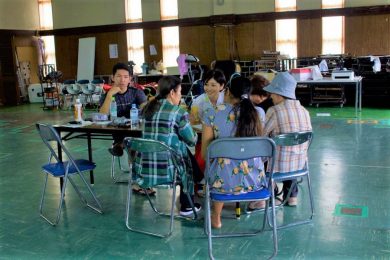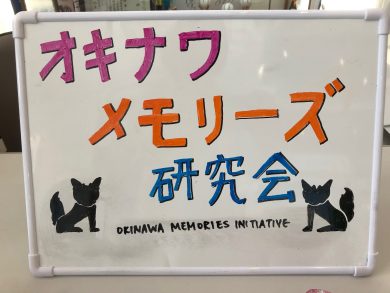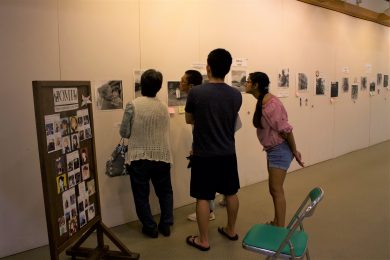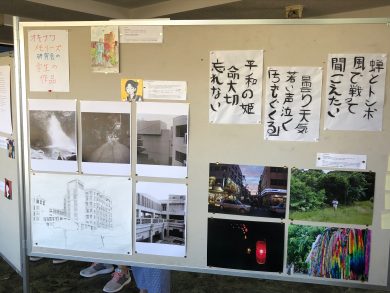Communicating through Oral History and Artworks

Nirupama Chandrasekhar, Tatsuki Kohatsu, and oral historian, Tomoko Kubota interview a group of elderly women at the Moromizato Community Centre.
The Okinawa Memories Initiative (“OMI”) is a collaborative history project that aims to expand Okinawan-American dialog. The Initiative is based at UC Santa Cruz and proudly sponsored by THI as part of our Center for the Study of Pacific War Memories. Following a successful crowd-funding campaign at UCSC Giving Day this year, the Okinawa Memories Initiative sent seventeen students on a summer research trip to Okinawa this summer to work on research exhibitions. These students from UC Santa Cruz, CSU East Bay, and CSU Monterey Bay were split into research, oral history, and exhibition teams, according to their interests. The teams worked together to record and curate exhibits, interacting with visitors and integrating themselves in Okinawan culture.
Nirupama Chandrasekha, an undergraduate student at UC Santa Cruz and the head of Media Production at the Okinawa Memories Initiative, was one of this year’s attendees. Nirupama reflects on this summer’s research trip to Okinawa, the third she has attended with OMI.

The sign for the Okinawa Memories Initiative, displayed at the front of every exhibition. Drawn by Tifa Yeh.
Going to Okinawa for a third time was really illuminating for me. In previous years, I found myself drawn to spatial history: it’s hard not to dwell on the ways in which geography impacts history and current events, [especially] when you’re stuck in a three-hour traffic jam on an island that’s only about 70 miles long! But this year, with a new focus on inter-university collaboration, oral history and the Gail photos exhibitions, I spent a lot more time speaking with people on island, and it was a very different, but incredible experience.
We got to meet our pen pals at the University of the Ryukyus, and discuss issues of importance with them: tourism, the military presence, and our futures in a changing world. But beyond these complex conversations, we were privileged to work together as teams, teaching each other skills in the field. My pen pal Tatsuki and I often went to oral history interviews or exhibitions together, and although at first Tatsuki acted as just a translator for me during informal conversations, he quickly become a facilitator in our conversation with other Okinawans as he learnt skills about interviewing and recording. We understood each other’s perspectives more and more as we spoke about our reactions and feelings to the stories that were shared with us.

Nirupama Chandrasekhar and Tatsuki Kohatsu listen to a middle-aged couple talk about the Gail Photos at Haebaru Cultural Centre.
I was always surprised by the level of candor and warmth that everybody on Okinawa seemed to bring to our conversations. We had expected people to be nervous or trepidatious about speaking with a large group of Americans like us, but many people on Okinawa desperately wanted their stories to be heard, even if, at first, they demurred, insisting they weren’t the important Okinawans we had to speak to. But eventually, they always started to tell us stories of their life: the process of making poisonous cycads into edible food, hitching rides with American soldiers to high school, long evenings spent learning eisa dances, or their first experience smoking a cigarette. Daily life has always been a focal point of the project, but this year, with our oral histories centered around ideas of indigeneity, being privileged with the personal stories of Okinawans really helped us understand the ways in which larger events shaped people’s day-to-day experiences.

Student artwork by Jared Guzman, Emily Aranda, Miki Arlen, and Kai Jones are displayed at the Henza Community Centre.
I was really humbled by the opportunity to go to community centers and sit down with the folks there and hear their stories. And yet, language often seemed like a barrier, with my Japanese being so limited, so I was really excited by the opportunity to express our feelings of wonder and gratitude through artwork at the exhibitions. By speaking to communities through film, sound, photos, drawings and poetry of the ways in which they had touched us and inspired us, I felt more connected to people in Okinawa than I ever had been before.
I’d always felt a special sense of joy from simply being on Okinawa in the past two years, but having had the opportunity to really sit down and speak with people in meaningful ways about culture, literature and the past this year, I can’t help but feel even more strongly tied to Okinawa.
—Nirupama Chandrasekha
Driven by the creative and scholarly work of UCSC undergraduates, the OMI encourages a broad public dialog across the pacific about the past, present, and future of the Okinawan-American relationship. Learn more about the Okinawa Memories Initiative by reading about their summer trip to Okinawa last year and THI’s brochure on the project.